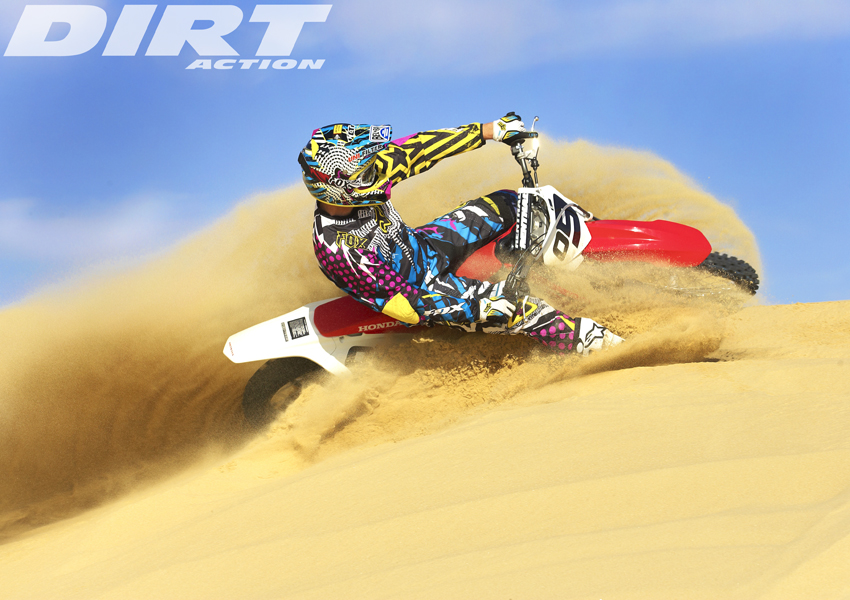IT’S A MAD HOUSE
Words Scott Bishop
I’ve been around the dirtbike world for a few years and would like to think I’ve seen most things, but every now and again a bolt from the blue makes you realise that although 30 years in racing is a long time there’s still a lot I don’t understand.
Most of this left-field knowledge comes from the Australian Junior Motocross Championships where, every year, 400–500 riders assemble for A week. For me, it’s not just about the racing as there’s far more going on than dirtbikes going around in a paddock.
MY PET HATE
About a decade ago, one club looking to raise revenue decided to charge for pit sites. If you wanted a good spot, you paid for it. Prices over the years have varied anywhere between $150 and $500 for a three-by-three-metre area in the pits.
I strongly disagree with paying for pit sites. Sure, there are free sites and riders will be allocated those if requested, but I believe that the entry fee a rider pays to enter any national event now should entitle them for a small chunk of space to set up a tent to park their bikes under.
At Yamaha, we don’t pay for pit sites and we can generally be found out the back of the pits somewhere. The money to pay for our 12 riders to have pit sites must come from somewhere but I would much rather allocate each rider some more parts than to have a pit area at the AJMX.
This isn’t a dig at the Appin club as they were very accommodating in pit space, but I do think at a time when money is tight and numbers are dropping the extra cost of a pit site probably won’t attract riders to competing at events that do it.
HELMETS
At the recent Appin event, the officials using motorised transport to get around the place didn’t use helmets. Now, the riders were made to push their bikes through the pits for a week, which is fine, but the people in charge rode and then choose not to wear a helmet.
I can tell you that, working for a manufacturer, wearing safety gear when on a motorised vehicle is essential. To have officials ride around without a helmet in front of 500 mini riders probably isn’t the look I think we need to be going for, but maybe that’s just me.
But, speaking of helmets, one of the officials who worked in the start/marshalling area wore a hard hat for the entire event. He also ran the mandatory hi-vis vest but the hard hat made me curious. Just what was going on in that start area that required a hard hat? Every time I went in there I kept looking up to see what might fall out of the sky or if there was some crane work going on above us.
Maybe he was expecting things to get physical in there, which has been known to happen at the Junior Nationals. Or, as the Kiwis were told, there were drop bears in the area. All I know is that guy took workplace health and safety to a new level. He was a great guy though and did his job well all week, but I’m sure everyone wanted to know the story behind the hard hat.
PAINT
The worst combination you can have is an over-zealous official who likes painting. At the Junior Nationals, cylinders and barrels are painted in an effort to stop cheating and oversized motors. This usually happens once at the beginning of the meeting and then, if the bike needs to be pulled down during the event, the paint is reapplied once cleared.
Well, this year there was a double dose of painting and by the end of the week most bikes looked like they were right out of the Dulux colour chart. In fact, I’m surprised no one said there were riding a Taubman 250, there was that much paint on there. I bet most riders will be out with the Little Ripper stripper the moment they get home to remove the rainbow of colours from their cylinders.
And you don’t want to get me started on the one-hour riders briefing or the two-hour lineup for machinery. That’s another three hours of my life I won’t get back.
IN THE DETAIL
I was recently involved in some ride days where people were invited and encouraged to ride the new Yamahas. We have had a media day and also one for the public here in Queensland and these days are always an eye-opener.
One particular rider jumped on a bike all excited for his time to spin some laps. I walked over and asked him if he’d like any levers, pedals or bars moved or have the ride height set for him. He quickly pored over the bike, snapped the throttle a few times and said, “Nope, I’m good to go!”
He then rode off and onto the track. I watched him ride around until he got about half a lap into his time, pulled off the track, cut back over and headed straight back to us. When a rider only gets half a lap into it, usually something major is wrong.
He rode over and, with about 100 tools in hand, I asked what was wrong. He looked me dead in the eye and said, “Can you adjust the kill switch down a little please?”
I got my Phillips-head right-handed screwdriver out, loosened her off a quarter of a turn, moved the kill switch maybe 3mm until I got the official nod and then locked it up again. He then rode off to complete the rest of his time on the bike — and loved everything about it.



